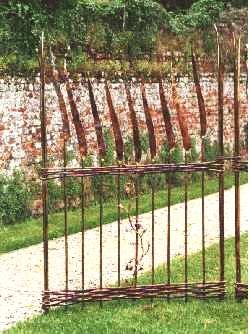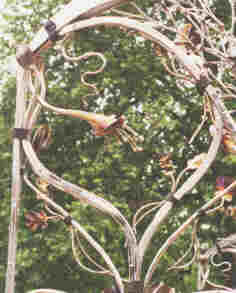Giusseppe Lund - Sculptor & Architectural Metalsmith
Giusseppe works with hot metals and glass at Metalgarden Ltd. and has studios in the UK and Canada.
His work can be found throughout the world and he is featured in several books on metalwork. Over the last 30 years he has channeled much of his energy to the promotion of creativity with metals and has been a strong influence upon the development of contemporary smithing in the UK. In the 1980's he encouraged the Victoria & Albert Museum in London to have an international exhibition of forged ironwork, "Towards a New Iron Age" and he was an advisor to the Crafts Council of Great Britain when the International Conferences of Blacksmiths were held at Hereford, UK.Sites you may know in London are Victoria Plaza at Victoria Station, Westferry Circus at Canary Wharf, and the Queen Elizabeth Gate at Hyde Park.

His early search for an understanding of forging took him to Germany and Italy where he had the pleasure of working with people such as Manfred Bergmeister and Toni Beneton. The free use of metals in Europe gave him the confidence to develop his own style back in England where at that time metal design was still dominated by the styles of the 18th & 19th Centuries. By working with industrial smiths and their large hammers his interest in forging was driven by a fascination with the fluidity of steel under heavy pressures and the metals' sensual and feminine qualities. He found traditional methods of fixing cumbersome and had no compunction about mixing his forged elements with modern techniques of welding and cutting.
Thanks to tremendous support from the Crafts
Council, The National Coalboard, British Steel and a wide variety
of dedicated clients Giusseppe was able to establish two large
studios and to train several young people. Most work has been to
commission - several large works being the result of design
competitions - but more recently he has tended to visualise a
project and then seek support to create it. The latter approach
has led to working closely with community groups and has enabled
the public to gain much from his educational strategy.
Over the years Giusseppe has moved from light hearted medieval shapes to bold textural bulk and freely growing organic forms. His greatest influences have been the search for the underlying common factors of religious belief and an attempt to express the cyclical nature of Life. Early dark and heavy forms have been superceeded by sparkling and vibrantly colouful surfaces. This has been greatly enhanced by the use of forged and oxidised stainless steel and bronze. The combining of hot worked glass has also opened up inner surfaces and the use of water and light is becoming increasingly important in his work. His recent training in Chiropratic has changed his outlook profoundly and whereas his earlier forms were the result of a personal metaphysical journey he now has a strong desire to inspire "well being" and the joy of living. (back to top)
Public awareness of the "holistic" aspects of health and a growing tendency for a "percent for art" policy in building development is giving architectural artists an exciting new resposibility in the shaping of our environment. Giusseppe is dedicated to the principal of "happy, healthy spaces.
At present, I am working on an entrance for
the new Sun Life building in Bristol, a life-size sculpture of a
Viking  ship
for Laags in Scotland , and an entrance for Circus Space, Hoxton
Square in London. There are also two community projects on the
go, Metalgarden and an instalation for the Sea walk at Hythe,
Hampshire, England.
ship
for Laags in Scotland , and an entrance for Circus Space, Hoxton
Square in London. There are also two community projects on the
go, Metalgarden and an instalation for the Sea walk at Hythe,
Hampshire, England.
Detail from The Queen Elizabeth Gate, Hyde Park, London, England
This was a commission by the nation to celebrate the life of Her Majesty Queen Elizabeth the Queen Mother.
So why the Internet ?!!
I love to involve the public in my projects. Recently an arts centre in the New Forest invited me to help with an interactive theme for their garden. The idea is to run workshops and discussion groups exploring people's ideas about "the garden". It is a universal subject and a great opportunity to create a sculpture that any one can relate to on every level. The final piece will be a permanent part of a public garden. It seems a natural development to take this onto the Internet.
My pilot pages invite input from visitors and the aim is to update the site with shapes and sketches which are a direct response to people's ideas. I believe that such a dialogue will break down some barriers that surprisingly still exist between artists and the public.
By using Java applets I hope to introduce some of the qualities of metal such as sounds, texture and movement and I have also composed some interesting video animation. What I find so interesting is that these Html pages act as a stand-alone interactive programme, off-line . I intend to make good use of this with children when I visit schools.
All of this is leading to my next project which is an exhibition where people can evoke similar responses from real objects to that of clicking on text and pictures in Html. Changes in the environment will be the direct result of the viewer's input. This will take place early in 2004 and will have a parallel site on the Internet.

